Menu
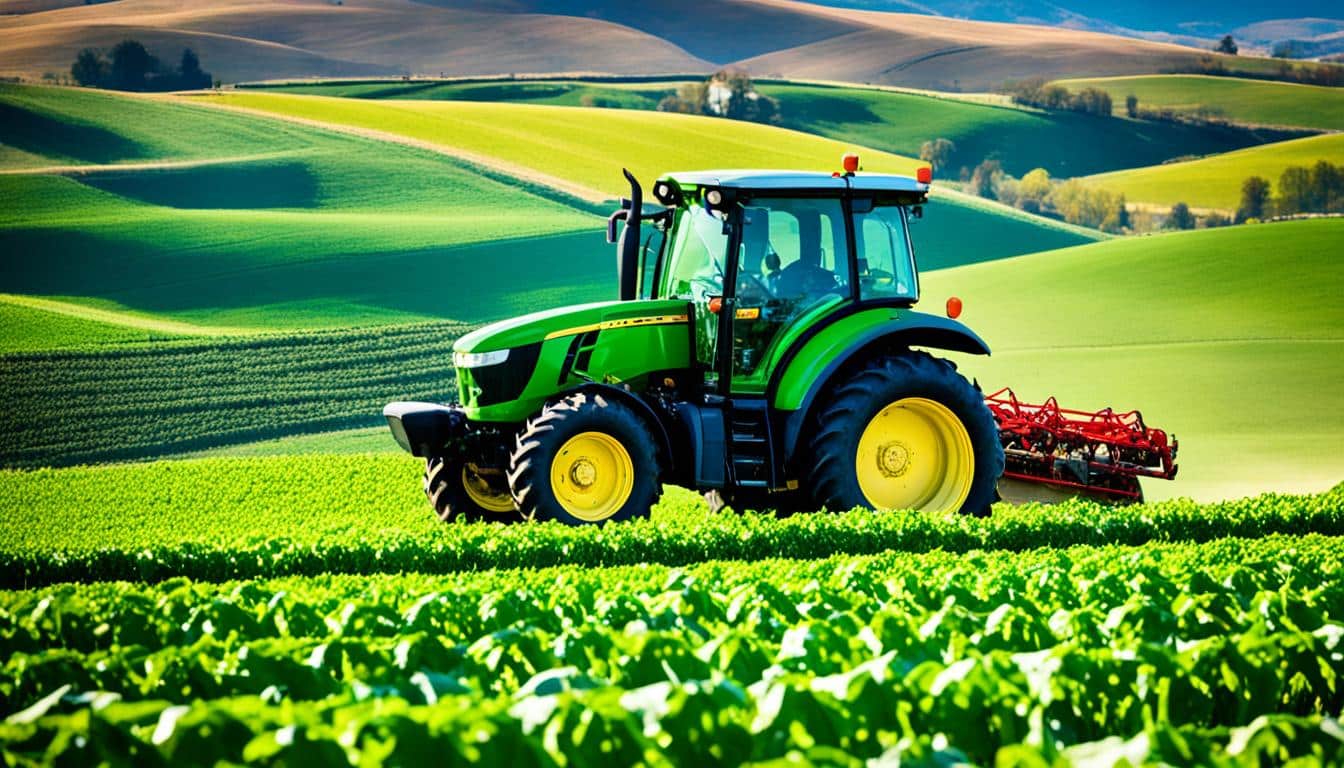
Did you know the interest rate for Farm Ownership – Down Payment loans is now as low as 1.500%? This is great news for farmers. It means they can get important machinery at a lower cost. Things like tractors and combines help farms be more productive and make more money.
Farm equipment financing is made just for buying agricultural machinery. It uses the machinery itself as security, making it less risky for the lender. This can lead to better loan conditions for the borrower. It’s important to know about the different farm equipment loan options available.
Farm equipment loans are key for farmers to get the tools they need. This includes tractors, combine harvesters, and more. Finding the right loan is important for a successful farm.
Agricultural machinery loans help farmers buy the tools they need. The machinery acts as its own security, making loans less risky for lenders. This way, farmers can get better loan deals to boost their farm’s output.
These loans can cover a wide range of farm equipment. This includes tractors, combines, harvesters, and planters. Even combine harvester lease and livestock equipment loans are possible. This gives farmers many choices for their financial needs.
The machinery bought with the loan is often used as security. This lowers the risk for the lender. But, because equipment loses value over time, these loans can have higher interest rates.
Repayment terms are often matched to the machine’s lifespan, which can be 1 to 10 years. Lenders might also be flexible with payment plans. It’s vital for farmers to understand these points to make the best money decisions for their equipment.
Understanding farm equipment financing can really help your farm. This part will look at loans, how to pay them back, and the interest rates. You’ll get a complete picture of how this works.

Farm equipment financing works like other business term loans. You borrow money that you then pay back with interest. Big lenders like AgDirect and John Deere Financial have special loan options. John Deere Financial, for example, offers the Multi-Use Account. It lets you pay for everyday and seasonal items with one credit line. This makes managing your money easier.
| Lender | Types of Equipment | Special Features |
|---|---|---|
| John Deere Financial | Used Equipment | Competitive financing for top-quality used ag equipment |
| AgDirect | Tractors, Combines, Centre Pivots | Financing from major brands like John Deere, Case IH |
How you pay back farm equipment loans can be different. Usually, you make fixed payments each month, quarter, or year for a set time. AgDirect lets you make payments over three to seven years, or up to ten years for certain equipment. This means you can find a plan that fits with how your farm makes money.
Leasing farm equipment can mean lower payments than buying with a loan. These lease payments can also be tax-deductible, which is a bonus.
Interest rates for farm equipment loans often range from 5% to 15%. The rate you get depends on your credit score and how much you put down. With AgDirect, the interest rate changes with the market, making payments steady. You can also choose to switch from a changing rate to a fixed one without extra fees, a feature not all loans have.
It’s key to talk to finance pros to understand interest rates better. Knowing how rates might go up or down can help you make smart choices for your farm.
Getting financing for farm equipment can be critical. Government-backed options provide good terms and low interest rates. This makes them a popular choice for farmers. Farm Service Agency (FSA) loans and Small Business Administration (SBA) loans are two main ones to consider.
Farm Service Agency loans support farm operations and ownership. They offer competitive interest rates, especially after May 1, 2024. They come in several types:
These loans are especially good for minority and women farmers. And also for new farmers. They help these farmers buy or operate farms.
FSA also offers loans for buying equipment for eco-friendly farming.
SBA 7(a) and 504 loans are great for financing farm machinery. These loans have long repayment periods and low rates. This makes buying farm equipment easier. The SBA 7(a) loan suits many needs, including buying machinery.
The 504 loan is for big assets like large equipment or real estate.
| Loan Type | Interest Rate | Purpose |
|---|---|---|
| Variable/Fixed | Prior business day’s SOFR + 6.75% | General farm equipment |
| Fixed ≥ 5 years | Prior business day’s 5 Year Treasury note rate + 5.5% | Major equipment purchases and real estate |
Using these loans can help farmers get the machinery they need. It boosts productivity and saves money on interest. For more on FSA loans, visit the official FSA website.
Modern online equipment lenders are perfect for fast financing. This is ideal for farmers needing to buy new equipment. The loan process is simple, and they have more flexible rules for who can qualify.
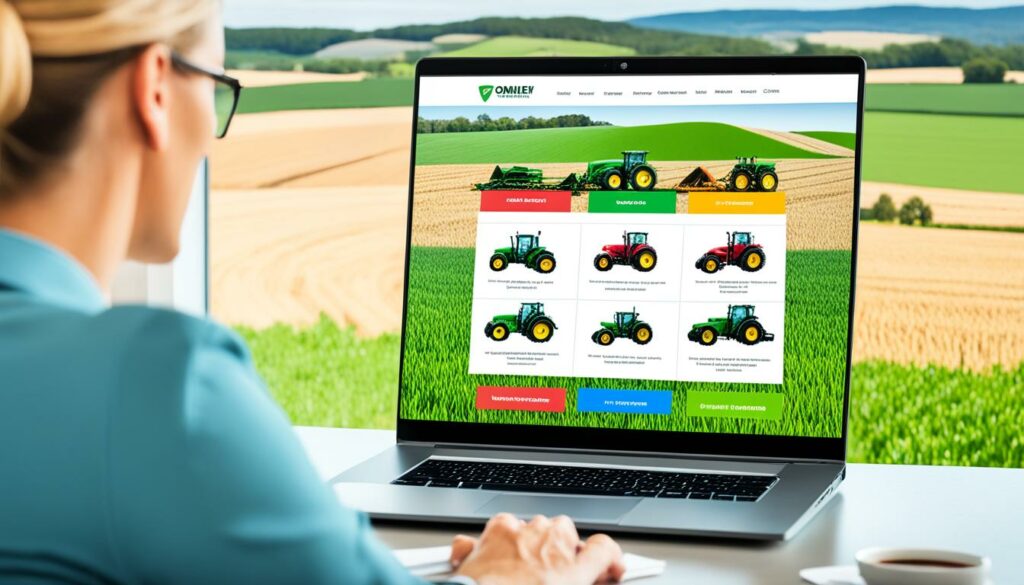
Online lenders are quick and efficient. They can approve your application in just 24 to 48 hours. This is great for farmers needing funds fast. The application is easy, with less paperwork to worry about.
Online lenders are often easier to work with than banks. This is because they’re willing to help, even if you don’t meet strict bank criteria. It’s especially good news for younger farmers with less credit history.
Quick and easy loans from online lenders might cost more in interest. Rates can be between 5% and 15%. But, these lenders offer flexible payment and term options. They understand farmers’ cash flow and offer to skip payments when needed.
| Lender | Interest Rates (APR) | Repayment Terms | Funding Speed | Special Features |
|---|---|---|---|---|
| Online Equipment Lender A | 7.59% – 12% | Up to 84 months | 24 – 48 hours | Flexible qualification requirements |
| Online Equipment Lender B | 11% – 15% | Up to 96 months | 48 – 72 hours | Streamlined applications |
| Online Equipment Lender C | 9% – 13% | Up to 72 months | 24 – 48 hours | Flexible repayment options |
Working with online lenders offers speed and flexibility. But, it’s vital to compare terms and offers. This ensures you get the best deal for your farm and finance needs.
Working with specialized agricultural lenders can be a huge benefit. They understand farmers’ unique needs and challenges. This helps them offer financial products that fit farming’s seasonal demands.
Agricultural lenders in specific networks, like Farm Credit, provide expert advice and tailored financial solutions. Their deep knowledge of farming means they structure loans that work with farming’s cash flow. Specialised lenders also offer more flexible terms and rates, making them appealing to farmers who need financial help.
One key advantage is their focus on agricultural equipment loans and leasing. This is crucial for buying expensive machinery. These lenders understand the special risks and needs of investing in agriculture.
AgDirect, a part of the Farm Credit network, is one of these respected lenders. They directly finance equipment for farmers. They offer various programmes to match different farm needs, including loans for:
Farm Credit’s network supports farmers with direct funding across various needs and scale. It helps both large and small farms. They aim to aid the agricultural community with loans for equipment and daily operations.
Specialized lenders, such as those in the Farm Credit network, are vital for farming success. They offer crucial expertise and flexible financial support. This is key for boosting agricultural productivity and sustainability.
Knowing the many farm equipment financing options is key to picking the right one for you. There are traditional loans and special lease deals to choose from. Each has its own good points. Now, let’s look at the main ways you can finance farm equipment.
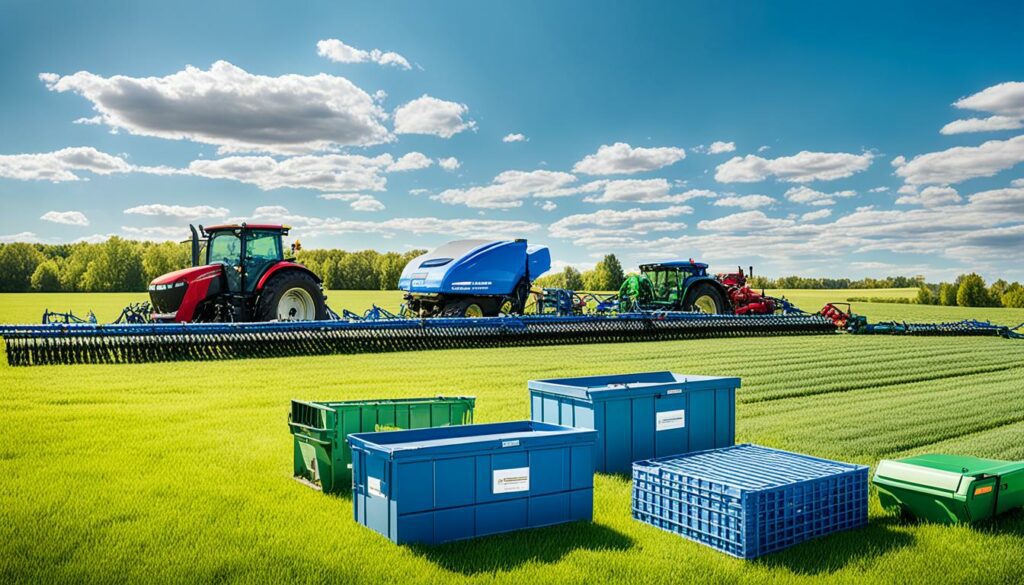
One way to pay for new machinery is with an agriculture equipment loan. You’ll make fixed payments each month. Plus, you can pick from several ways to pay it back. These loans usually don’t need anything extra as security, which is good news. Big-name banks like Wells Fargo and US Bank often offer them. They help farmers get their hands on vital tools, like tractors and combines, quite easily.
Equipment Finance Agreements
With an equipment finance agreement, you can spread the cost over time without adding more stuff to secure. It’s a nice option for owning machines long-term without risking your other stuff. Experts can help choose the right deal for your budget and needs.
Agriculture Equipment Leases
Leasing farm equipment covers all the costs, even things like warranties and taxes. Leasing can be great because of tax perks and options at the end. But, watch out for fees if you end the lease early. Big names like AgAmerica help with easy payments and options to buy or continue the lease later.
Lender Comparison
It’s very important to compare lenders well. For example, Farmer Mac often has lower rates than others and you can choose how often you pay – each month, quarter, or year. They also offer loans for up to seven years and a quick okay in as little as 48 hours.
| Financing Option | Down Payment | Repayment Terms | Benefits | Potential Drawbacks |
|---|---|---|---|---|
| Agriculture Equipment Loans | Varies by lender | Fixed monthly payments | No additional collateral required | High upfront investments |
| Equipment Finance Agreements | None, other than the equipment | Flexible | Long-term ownership | Depreciation risk |
| Agriculture Equipment Leases | 10% or less | Varied, as per lease terms | Tax advantages, end-of-term flexibility | Fees on early termination |
| Farmer Mac | Varies | Up to 7 years | Competitive interest rates, quick approval | Eligibility criteria |
To sum up, look at all your agricultural equipment financing choices and compare lenders well. This way, your farm can get the best financial help. Every option has unique benefits for your farm’s budget, making it easier to keep your farm running smoothly.
To get a farm equipment loan, you need to know your financial needs and credit score. Plus, grasp how down payments work. Understanding these areas will boost your chances of getting a loan.
Start by figuring out which tools you need and the cost. Farm equipment loans vary, but usually range between 5% to 15%. The type of loan and who issues it matters too. For example, microloans for farming can go up to $50,000.
Your credit score impacts the loan terms you can get. A good score means better rates. But if your score is lower, you might face higher rates. Online lenders can be more flexible but could charge more. The SBA often backs these loans, making them more accessible.
Lenders often require a down payment, up to 30%. But, there are also no-down payment options. Preparing for this shows lenders you’re serious and capable. Make sure you have an exact quote for the equipment.
| Loan Type | Interest Rate | Max Amount | t
|---|---|---|
| SBA 504 Loans | 11.5% – 15% | $5.5 million | t
| SBA 7(a) Loans | 11.5% – 15% | Varied | t
| Farm Operating – Direct | 5.250% | $50,000 | t
| Farm Ownership – Down Payment | 1.500% | Varied | t
Knowing all this makes applying for a loan easier. It sets you up for better farm equipment financing.
Farm operating loans help agricultural businesses by providing funds. These funds are for buying equipment, getting livestock, and making small farm improvements.
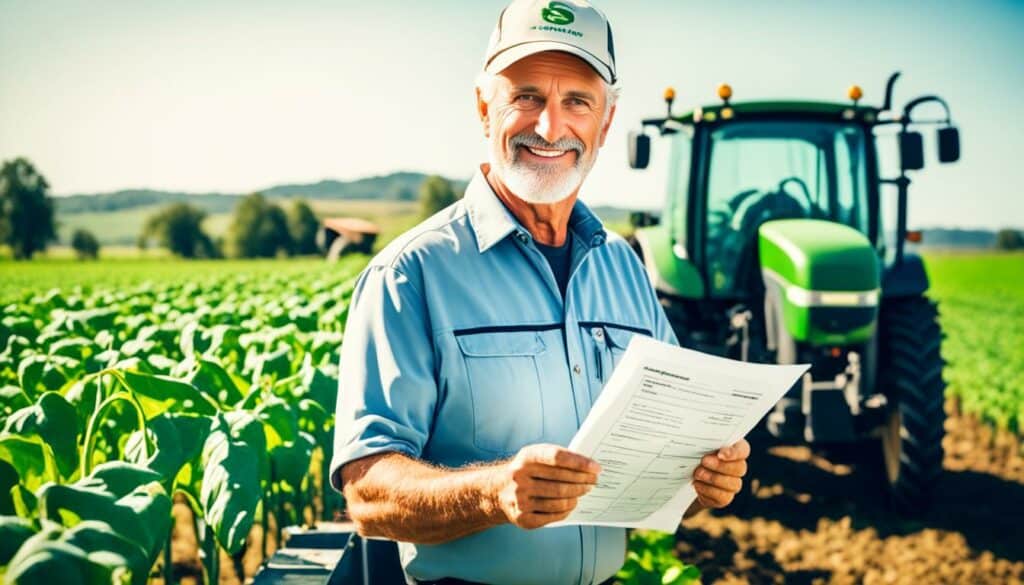
Farm loans are used for many immediate needs on the farm. They help with things like:
These loans need to be paid back within a year. They have lower interest than other loans. The biggest farm operating loan you can get is $400,000.
To get a farm loan, certain conditions must be met:
There are also FSA microloans for smaller farms. These loans are easier to get and have small requirements. No down payment is needed for a Direct Farm Loan.
This helps many farmers start. Even those with slow payments can qualify.
| Type of Loan | Maximum Loan Amount | Repayment Terms | Interest Rates |
|---|---|---|---|
| Farm Operating Loans | $400,000 | Within 12 months for general expenses; up to 7 years for larger purchases | Posted on the 1st of each month |
| FSA Microloans | Varies | Flexible terms based on the project | Same as operating loans |
| Agricultural Project Financing | Depends on project scale | Varies based on project requirements | Determined by risk and market competition |
Getting approved for a farm loan takes 7-10 days. Once approved, these loans, along with FSA microloans, support various farming projects. They help farms grow and stay sustainable.
Many farmers are choosing to lease farm machinery instead of buying it. Leasing offers flexibility and helps save money for other farm needs. It allows farmers to use the latest equipment without a big financial risk.
Deciding to lease or buy farm equipment depends on several factors. Buying gives you ownership and equity over time but needs a lot of money upfront. Leasing has lower initial costs and monthly payments.
Leasing also lets you keep your machinery up to date with new technology. This flexibility is a key advantage.
There are different lease types to suit various needs. Operating leases are good for equipment that needs frequent updates. They often come with extended warranties.
Finance leases are more like owning the equipment at the end. They last through the equipment’s useful life. You can often buy the machinery when the lease ends.
| Lease Type | Upfront Costs | Monthly Payments | Duration | Unique Features |
|---|---|---|---|---|
| Operating Lease | Low | Potentially lower | Short-term | Flexible updates, extended warranties |
| Finance Lease | Moderate | Moderate | Long-term | Option to buy, akin to ownership |
Farm machinery leasing allows for flexible procurement, not possible with just buying. Farmers can choose from leases that match their specific needs. Whether low upfront costs or long-term potential, there’s an option for everyone.
Farm Credit helps farmers by providing various loans for their different needs. These services are owned by customers and offer good interest rates. They know a lot about the farming industry. This makes their loans very valuable.
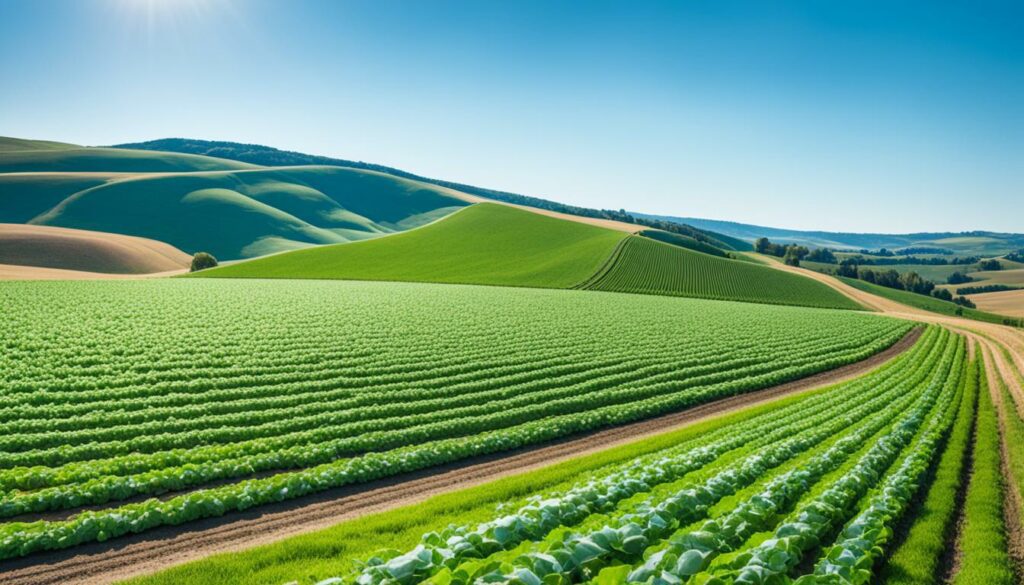
Farm Credit services have loans for every part of farming. They include operating loans for daily needs, equipment loans for machinery, and real estate loans for buying farmland. They also have loans for making farms better and for bigger farms to grow.
Farm Credit loans have better interest rates than regular banks. These lower rates make it easier for farmers to borrow. They also set funding limits that match farm sizes, helping everyone from small farms to big operations. This ensures farmers have the money they need to thrive.
| Type of Loan | Advantages | Considerations |
|---|---|---|
| Operating Loans | Short-term, lower interest rates | Repayment pressure, collateral might be required |
| Equipment Loans | Fixed payments, targeted financing | Longer terms, depreciation risk |
| Real Estate Land Loans | Land ownership, equity building | High upfront costs, market fluctuations |
| Agribusiness Loans | Expansion capital, tailored terms | Complex qualification, higher interest rates |
| Improvement Loans | Increased productivity, farm enhancements | Varying costs, potential downtime |
Farm Credit’s services are crucial for the farming world. They offer smart financial help with deep knowledge and flexibility. This makes farming life a bit easier.
Microloans offer an easy and adaptable way for small farms to buy the essential tools. If you grow special crops or help with community-supported agriculture (CSA), a microloan for equipment might just fit your bill.
If bigger loans are not easy to get, microloans are worth thinking about. They can be up to $100,000, with $50,000 max for both uses. These loans are great for buying equipment. They can also help with yearly costs and be paid back over seven years.
For operating loans, you might need to offer property or farm goods as security.
Applying for a microloan is simpler than for most loans. You need to show you know about farming or running a small business. Having a good credit rating is important.
You can borrow any amount up to $50,000. These loans can pay for everything from tools to soil projects. For buying equipment, you don’t need a long farming record or money from elsewhere. Microloans are quite flexible.
There are some musts like no drug-related convictions and some work in management. These loans are great for small farms wanting to grow without the headaches of complex loans.
Interest rates and times to pay back the loan can change based on why you’re borrowing. For buying equipment, you might have up to 25 years to pay back. The Farm Service Agency (FSA) helps a lot with technical advice.
Although the FSA doesn’t give grants, you can use other grants with their loans. This helps small farms a lot.
Direct and guaranteed loan programmes provide important help to farmers. They support those who find it hard to get normal bank credit. These plans are key to keeping farms running well all across the United States.
The *Farm Service Agency* (FSA) of the USDA gives out many types of loans directly. For example, Farm Ownership Loans can go up to $600,000. This helps farmers buy land or make it better. Farm Operating Loans offer up to $400,000 for costs like buying animals and seeds. And, Farm Storage Facility Loans can cover up to $500,000 for buildings and $100,000 for trucks.
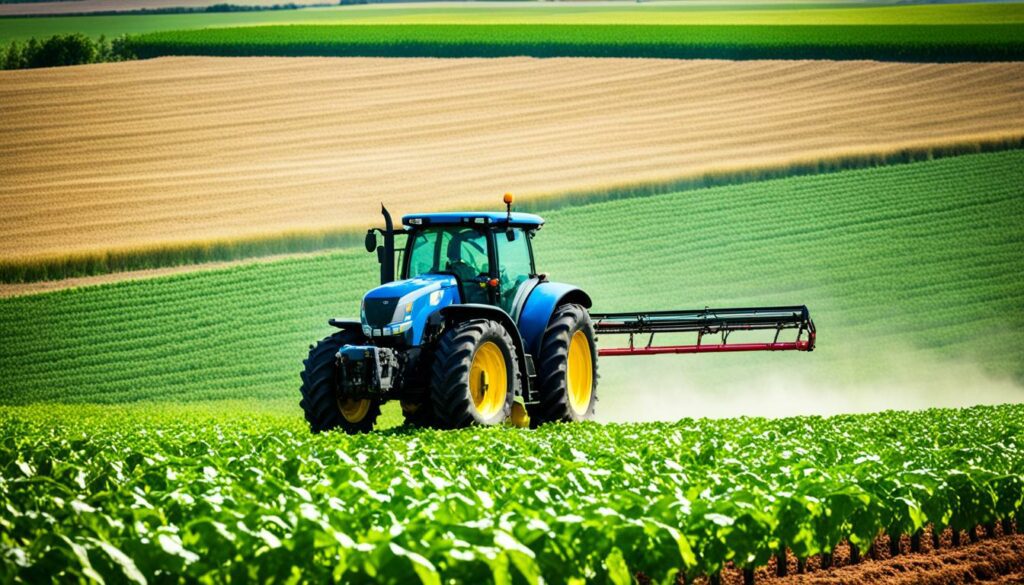
Guaranteed loans are also very important. They work with private lenders, like banks, with the FSA backing a big part of the loan. This makes it easier for farmers to get the money they need. Guaranteed loans can pay for things like animals and farm equipment.
These loans also support eco-friendly farming practices. Farmers can use the funds to buy equipment and use methods that are good for the environment. This way, farming can tackle climate challenges better.
Plus, the USDA offers other ways to help farmers through the Rural Development Agency. They give grants and loans to help with projects in rural areas. New farmers can take advantage of these to start and grow their farms.
The FSA provides guides to help with loan applications. And for loan management, farmers can use the farmers.gov website. It’s an easy way to make payments and check on loan details.
| Loan Type | Maximum Amount | Purpose |
|---|---|---|
| Farm Ownership Loans | $600,000 | Purchase or expand farms |
| Farm Operating Loans | $400,000 | Daily operating costs |
| Farm Storage Facility Loans | $500,000 | Build or upgrade storage |
| Guaranteed Operating Loans | Varies | Operating expenses |
Both direct and guaranteed loans are key to help American farmers. With *USDA guaranteed loans* and different *FSA programmes*, farmers can keep their farms growing. These tools are vital, especially during tough economic times.
Knowing your farm’s equipment needs is crucial for better agricultural work. You must carefully look at the machinery you need and how much it will cost. Planning well ensures you make smart choices that don’t hurt your farm’s efficiency, saving money where you can.
First, list what equipment your farm must have. This might include tractors, combine harvesters, or advanced systems like auto irrigation and GPS tech. Everything should be picked based on how it boosts productivity and the farm’s overall value. By looking at everything, you can see what’s most important for success.
Think about your farming machinery budget next. Knowing how much you can spend is key to making the right choices. Most often, you’ll need to pay about 35% as a deposit for loans, which can be okayed within a week or two. Your budget has to cover not just the equipment costs, but also loan rates and fees.
Being able to use the machinery as loan security and having a good credit score can make getting a loan easier. This way, you can match your equipment needs with what you can afford. This leads to better farming outcomes, without overspending.
Making your loan application smooth and efficient is key to quick funding. Focus on detailed preparation and cutting down on unnecessary steps. This will boost your chances of getting the loan approved swiftly.
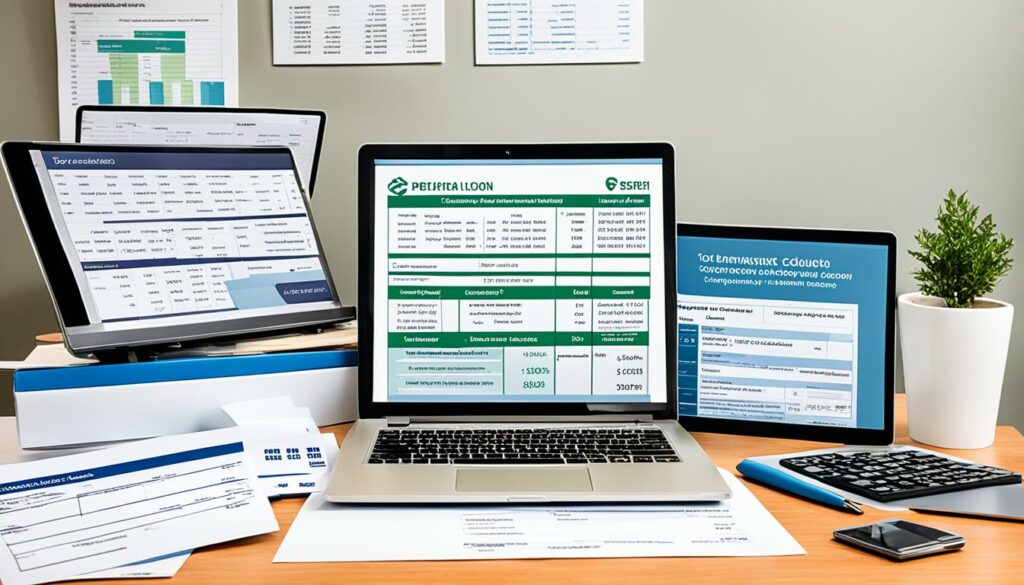
To apply efficiently, gather all the required paperwork first. This includes financial statements, tax returns, and even plans for your business. Make sure everything is current and correct. Lenders will view you more positively if your documents are in order.
“Financial institutions in the Chicago Fed district reported having less funds available for agricultural lending for the third consecutive quarter compared to the previous year.”
To get approved faster, use these tips:
In the Chicago Fed district, the demand for farm loans without real estate is rising. Interest rates are at a peak since 2009. It’s more important than ever to make your loan application as efficient as possible. This will increase your chances of getting the loan and better terms.
| Key Factor | Impact |
|---|---|
| Availability of Funds | Reduced, affecting lending flexibility |
| Interest Rates | Highest since 2009, influencing borrowing costs |
| Document Management | Efficiency can significantly expedite processing |
Finding the best way to finance farm equipment is key. It’s important to know your options, such as AgDirect. This knowledge helps farmers boost their productivity and financial strength in the long run.
AgDirect offers a wide range of financing for farm machinery. This includes tractors, combines, and center pivots. They offer flexibility with down payments from 0% to 30% and loan terms from three to seven years.
For pivots, the terms can go up to 10 years. They give you the chance to prepay without extra fees. You can also change your interest rate from variable to fixed for free, which helps keep your finances agile and efficient.
Good financing starts with smart planning and a solid business plan. It’s crucial to forecast your income and costs. You should also keep a good balance sheet and maintain a strong credit score. This score should be checked yearly.
Institutions like Experian, Equifax, and TransUnion can help with credit insights. They also support loan programs for farmers. Thanks to the USDA and Farm Service Agency, getting the right financing becomes easier.
Having a solid risk management plan is really important too. Start looking for financing several months before you need it. Understand how down payments affect your loan terms. Make the most of the available resources and programs.
With careful and smart choices, farmers can make their operations flourish. They can make sure their future in agriculture is bright.
A farm equipment loan helps farmers buy vital machinery like tractors and harvesters. It lets farmers use the machinery itself as security.
Equipment loans cover things like tractors, harvesters, and even livestock tools. Each lender has their own list of what’s eligible.
Yes. The machinery you buy will secure the loan. This lowers the risk for lenders and might get you a better deal.
These loans work like regular business loans. You borrow the money and pay it back with interest. The time you have to pay back often matches how long the machine will last.
Rates can be between 5% and 15%. Your rate is based on your financial history and how much you put down.
Government loans often have lower rates and let you pay back over seven years. They might also back part of the loan, depending on your history and if you qualify.
Online lenders are quick and have easier requirements. They’re good if you need fast money or can’t get a government loan. But, they might charge more in interest.
Specialist lenders like Farm Credit really understand agriculture. They offer loans designed for farmers. For example, AgDirect by Farm Credit gives loans and leases directly to farmers.
To get a loan, know what you need, check your credit, and think about a down payment. This can help, especially if your credit’s not perfect.
Leasing means you can use the equipment without a big upfront cost. It’s flexible. Buying outright costs more initially but is yours completely.
Farm Credit offers loans for all parts of farming, from running the day-to-day to owning equipment. They come with good rates and limits based on farmers’ needs.
Microloans suit small farms or unique projects that need various tools. They’re easier to get and have small, but usable, amounts.
Direct loans are directly from the FSA. Guaranteed loans are from commercial lenders, backed by the FSA. Both lower the loan risk for farmers.
Think about your farm and your budget. Look at what machines you really need. This way, you spend wisely without hurting your production.
Have all your financial info and machine details ready. Being thorough speeds up getting your loan, making funds available sooner.